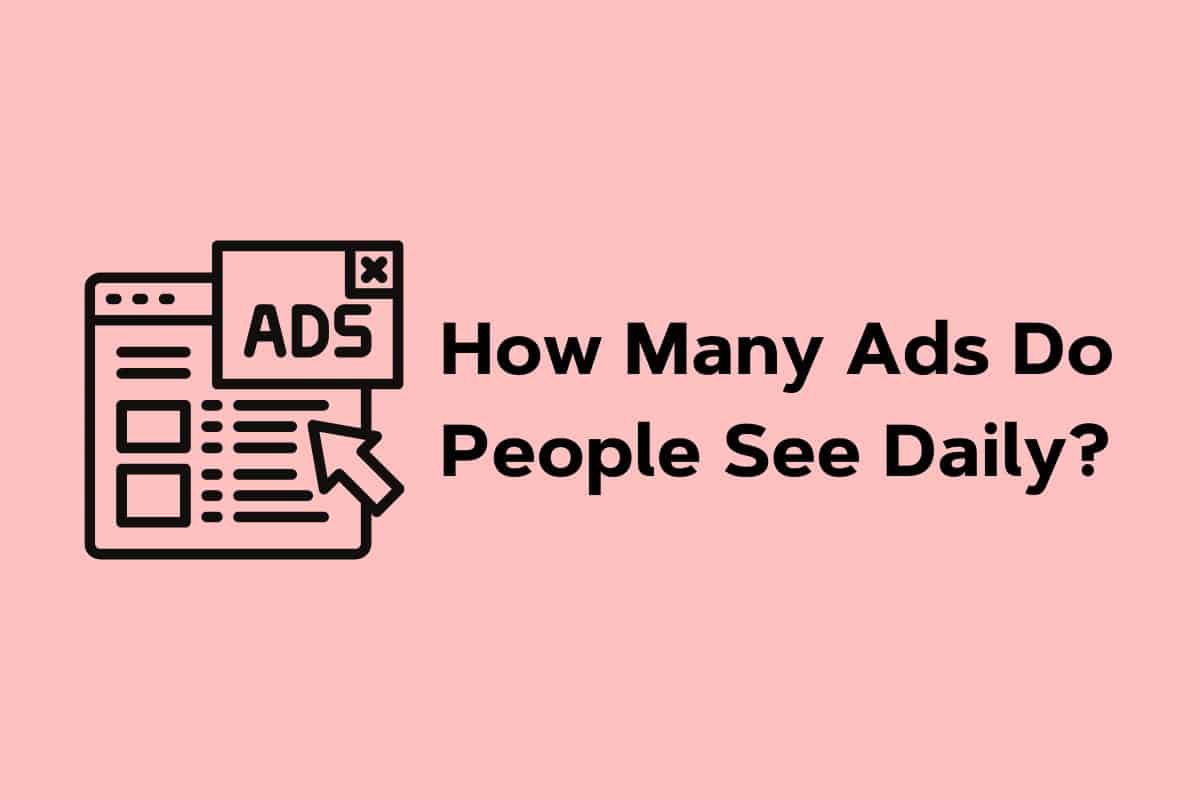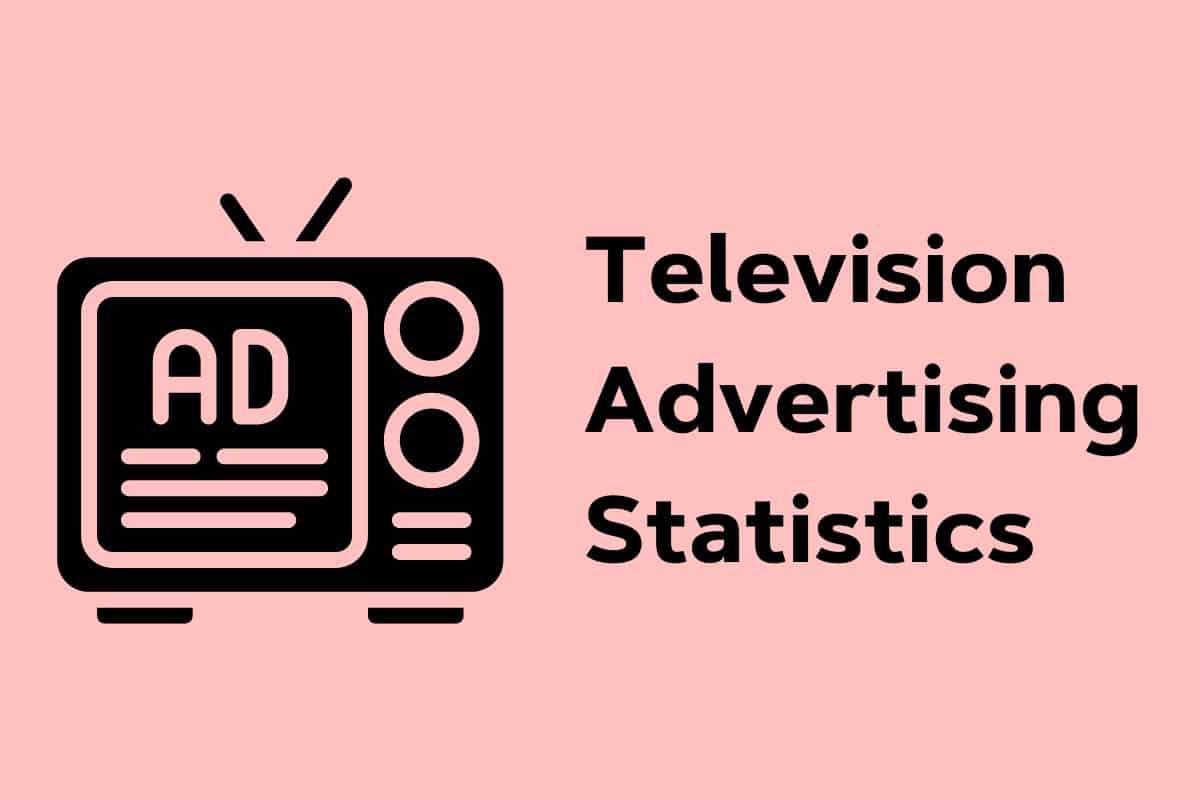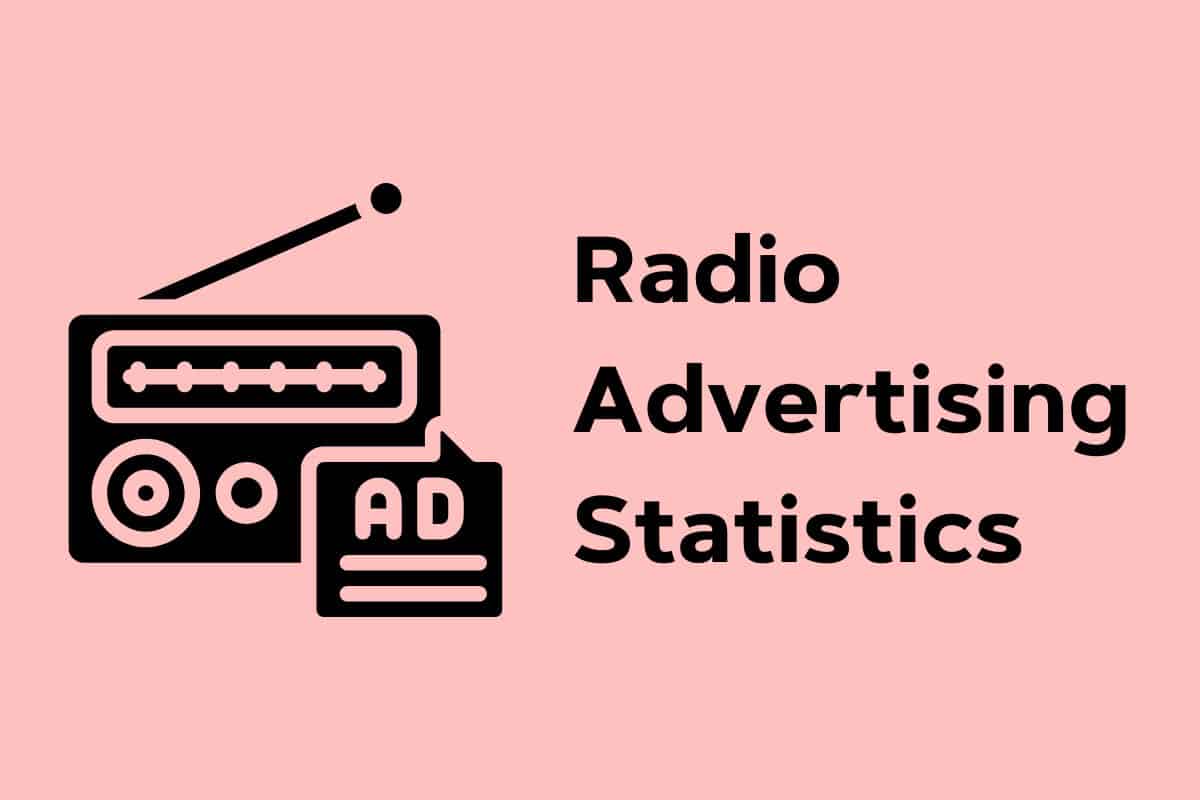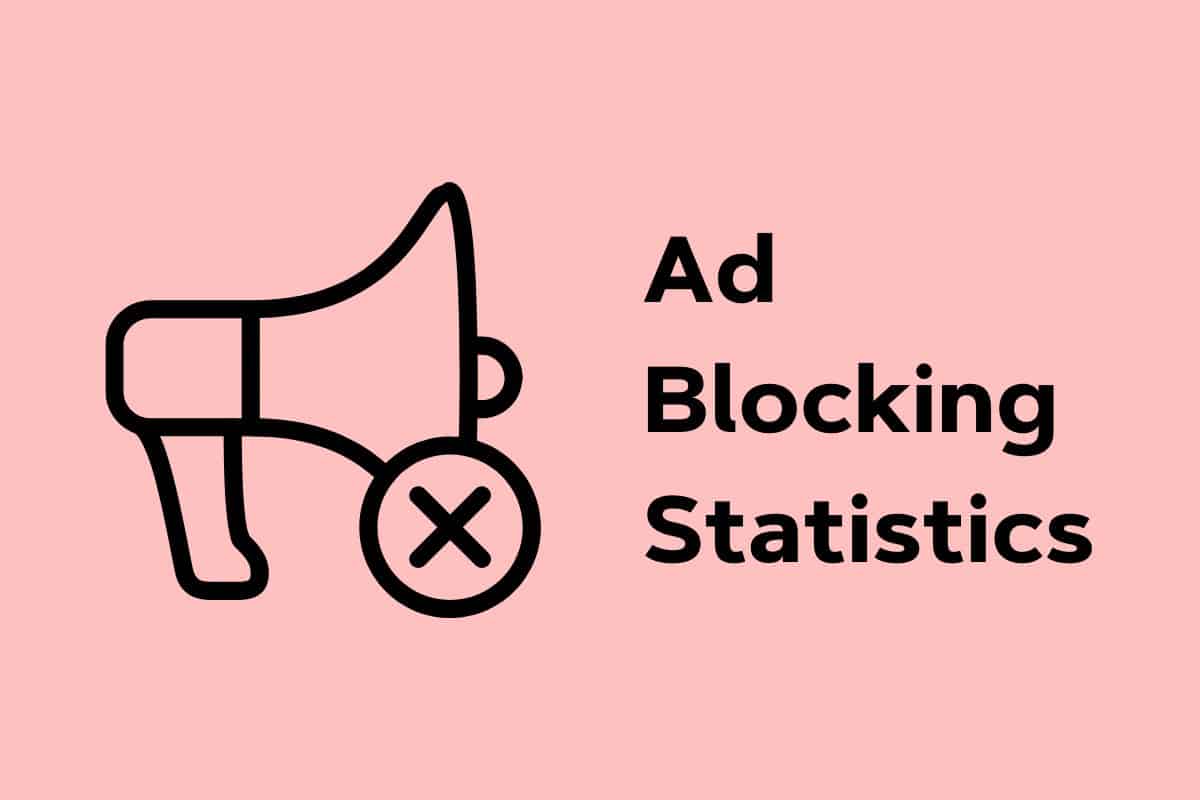Advertising Statistics (How Many Ads Do People See Daily?)
In this article, we’ll explore various key advertising statistics and trends to give you a better understanding of the industry.
The roundup covers all the most popular segments, like online, billboard, television, radio and print.
Plus, you’ll find an entire section that touches on the significant impact ad blocking software has on digital advertising and how much money is lost due to it.
It doesn’t matter if you are an avid advertiser, run an agency or are simply interested in the world of advertising, online and offline, read on to discover multiple fascinating insights that these stats bring to the table.
I’m still shocked by how many ads we see daily and how little attention we give to them.
Enjoy.
This post covers:
Advertising Statistics (Our Top Picks)
- An average American sees 4,000 – 10,000 ads daily
- But we bring our attention to less than 100 ads a day
- UK TV viewers see 36 television ads daily
- Search advertising is the largest digital advertising segment
- 68.7% of total ad spending will be mobile by 2027
- The US has nearly 352K billboards
- A Super Bowl ad costs $7 million in 2023
- 46% of US consumers say TV ads are the most memorable
- Only 12% dislike print advertisements
- $12.12 billion in loss of revenue due to ad blocking in the US
Before we continue, you may also be interested in our content marketing statistics.
How Many Ads Do People See Daily?

1. An average American sees 4,000 – 10,000 ads daily
You may think, “No, that’s not true; I don’t see that many ads.” The thing is, you notice only a few (see below).
The moment you wake up, you start getting bombarded with ads, Ads and more ADS.
Social media, news sites, television, radio, newspaper, billboards and shops – advertisements are at every swipe, step and look – all around us.
Thus, we ended up seeing anywhere from 4,000 to 10,000 ads per day.
Ridiculous, I know!
Source: Red Crow Marketing
2. But we bring our attention to less than 100 ads a day
We developed strong ad blindness because otherwise, we’d go insane. But this ad blindness is the main reason why businesses need to showcase the same ad multiple times for a potential consumer to notice it.
As it turns out, out of those 4,000, heck, 10,000, we notice or bring our attention to to less than 100 ads.
Moreover, the ones we consciously think about (and share with friends) are far fewer than 100 – more like 10.
Source: Red Crow Marketing
3. People were exposed to 500 ads in 1970s
According to Jay Walker-Smith, we were exposed to approximately 500 (some resources say upwards to 1,600) advertisements in 1970s.
But then the internet era came and skyrocketed the number of ads we’re exposed to every single day.
Source: CBS News
4. 763+ million people used adblockers worldwide
In 2019, there were 763.5 million people around the world who used ad blockers on their mobile and desktop devices.
Moreover, in 2021, there were 290 million desktop adblock users and 530 million mobile adblock users. That’s a 56.5 million increase in overall users with adblocking tools turned on globally since 2019.
As a reference, only 54 million users had an ad block app/plugin in 2013.
Source: Statista #1, Statista #2
5. UK TV viewers see 36 television ads daily
On average, people in the United Kingdom saw 36 television ads in 2021, which is more than half less than the year before (the average in 2020 was 77 TV ads per day per person).
Source: Statista
6. 17 minutes of radio commercials per hour
While we couldn’t find any statistics on how many radio ads does a person hear per day, Kagan found that radio news and talk shows play, on average, 17 minutes of commercials per hour and 14 minutes during music shows.
Fun fact: Some countries have a set time limit for how many minutes of ads a radio can play per hour.
Source: Inside Radio
Online Advertising Statistics

7. Digital advertising ad spending is expected to reach $680 billion in 2023
Digital ad spending has grown steadily over the past decade, with an expected reach of $679.8 billion in 2023.
More businesses are moving online, where the majority of highly engaged users and potential customers are. In January 2023, there were 5.16 billion internet users globally, which tells more than enough.
However, peeks at these internet stats for more amazing facts and trends.
Source: Statista
8. Search advertising is the largest digital advertising segment
Of all the different types of online advertising, search advertising has the most enormous market volume, valued at $279.3 billion in 2023. Why? Because it has the highest return on advertising spending (ROAS).
Example: For every $1 spent, the US advertisers gain around $11.
(We also curated the best search engine statistics you must check.)
The second and third largest sectors are social media and video advertising. Audio, influencer and classifieds advertising are much less popular methods.
Ad spending in other digital advertising segments
| Digital advertising segment | Ad spending |
| Social media advertising | $207.10 billion |
| Video advertising | $176.60 billion |
| Banner advertising | $161.80 billion |
| Influencer advertising | $30.81 billion |
| Classifieds | $21.05 billion |
| Audio advertising | $10.14 billion |
Source: Statista
9. The US will spend $271 billion on digital advertising in 2023
Out of all the countries around the world, the highest ad spending happens in the United States, forecast at $271.2 billion in 2023.
Like globally, the US’s largest online advertising segment is search, with a volume of $118.2 billion in 2023.
How much do other countries spend on advertising?
| Country | Digital ad spending |
| China | $173.60 billion |
| United Kingdom | $41.24 billion |
| Japan | $25.61 billion |
| Germany | $16.69 billion |
| Canada | $14.91 billion |
| Australia | $12.56 billion |
| France | $10.88 billion |
| Brazil | $8.96 billion |
| Italy | $5.84 billion |
| Mexico | $4.99 billion |
Source: Statista
10. 68.7% of total ad spending will be mobile by 2027
With the rise of mobile users came the opportunity for digital advertisers to invest more and more in handheld devices. Nearly 69% of all digital ad spending is expected to be dedicated to mobile in 2027.
Don’t forget to check our in-depth mobile marketing statistics and mobile commerce stats.
Source: Statista
11. 80% of media buying will be automated by 2027
Artificial intelligence and automated technology are touching every industry in the world, including digital advertising.
It’s said that programmatic or automated media/ad-buying advertising will reach 80.6% of all digital advertising in 2027.
Source: Statista
12. The average ad spending per user is $23.2
The average ad spending per user per entire digital advertising will be around $23.2 in 2023. The most expensive advertising per user is in-app and the least classifieds.
| Digital advertising segment | Digital ad spending/user |
| In-App advertising | $58.99 |
| Search advertising | $52.39 |
| Video advertising | $33.13 |
| Banner advertising | $30.35 |
| Audio advertising | $7.59 |
| Influencer advertising | $5.78 |
| Classifieds | $1.11 |
Source: Statista
Billboard Advertising Statistics

13. The US has nearly 352K billboards
From 2021 to 2022, the number of billboards in the United States increased by a mere 0.3% to 351,800. Note that the largest recorded number of billboards in the US was in 2017 – 369,000.
The research included bulletins, digital billboards, (junior) posters and wall murals. The most significant spike was seen in digital billboards, which increased by 80% between 2016 and 2022.
But the most common OOH displays are transit and place-based ads, with 2.3 million and 1.4 million pieces.
Source: Statista
14. OOH ads reached $8.6 billion in 2022 in the US
The out-of-home (OOH) advertising revenue grew to approximately $8.6 billion in the US in 2022, a 20% increase. The number is just slightly higher than in the pre-pandemic year (2019), $8.56 billion.
Source: Statista
15. The US spends $2.64 billion on digital OOH advertising
I’ve mentioned that digital billboards are growing the most, with around 11,600 displays spread around the country. The spending on digital OOH advertising also grew by more than 28% to $2.64 billion, and it’s predicted to reach even higher numbers.
Source: Statista
16. An average city light poster cost in Germany is $17.7 per day
From 2022 to 2023, the average cost of a city light poster in Germany increased by $0.18 to $17.7 per day and space.
Source: Statista
17. 31% of US people look at billboards
There was a study done in 2020 that looked at how many people actually look at outdoor billboards. 31% of respondents said they look at them most of the time, while 38% only sometimes.
I notice a billboard quite frequently – at least I think so – what about you? How many did you see today? I saw 11.
Source: Statista
18. 32% of people like billboard advertising in the US
A survey (March 2022) on consumer attitudes toward billboard ads found that 32% of people in the United States enjoy billboard advertising. Moreover, 11% dislike these types of ads, while the rest are neutral.
Source: Statista
19. Western Europe spends approx. $6.7 billion on outdoor advertising
The outdoor advertising spending in Western Europe in 2021 was $6.07 billion, but the prediction was that it would increase by 10.5% by the following year to $6.71 billion.
Source: Statista
Television Advertising Statistics

20. TV advertising revenue to hit $158 billion in 2023
While you would think that television advertising is dying, it’s FAR from it. In fact, it has a pretty steady annual growth of 1.5%, which isn’t too much at first glance.
But it is when you look at the numbers – $157.7 billion – the estimated TV ad revenue for 2023 (approx. one-fifth of the total worldwide ad spending) gives you a better understanding of its vastness. In 2022, the TV ad revenue was $155.4 billion.
Furthermore, by 2027, the revenue is expected to surpass the $170 billion mark.
Source: Statista
21. TV ad spending around the world
North America has been the leader in television ad spending for many decades. But the United States is the largest ad market regionally and globally, with expected growth over the next year.
| Country | TV ad spending |
| United States | $66 billion |
| Japan | $17.6 billion |
| China | $12.59 billion |
| Indonesia | $6.87 billion |
| United Kingdom | $5.24 billion |
| Germany | $4.95 billion |
| France | $3.71 billion |
| Russia | $2.66 billion |
Source: Statista
22. How much does a Super Bowl ad cost?
The average cost of a Super Bowl ad has been increasing steadily for the past ten years. In 2023, advertisers are paying, on average, $7 million for a thirty-second-long commercial during the broadcast.
| Year | Average Super Bowl ad cost |
| 2023 | $7 million |
| 2022 | $6.5 million |
| 2021 | $5.5 million |
| 2020 | $5.6 million |
| 2019 | $5.3 million |
| 2018 | $5.2 million |
| 2017 | $5 million |
| 2016 | $4.5 million |
| 2015 | $4.25 million |
| 2014 | $4 million |
The further survey found that 71% of viewers enjoy watching commercials during sporting events and for 79% they’re part of the entertainment. In addition, 59% said they would rather not see political ads during Super Bowl.
Source: Statista
23. Procter & Gamble spent $844 million on TV ads in 2021
Procter & Gamble was by far the largest advertised spending on broadcast network TV in the United States alone, spending a whopping $844 million.
As a reference, Amazon and Berkshire Hathaway were second and third, spending $496 million and $490 million.
Fun fact: Procter & Gamble spent even more on advertising in Germany – approximately $1.9 billion. Ferrero was the second largest (661 million €) and Amazon the third (359 million €).
Source: Statista
24. The first TV ad ran on July 1, 1941
The very first paid television advertisement dropped to the US screens on July 1, 1941, during a baseball game between the Brooklyn Dodgers and Philadelphia Phillies.
The advertisement promoted Bulova watches which cost around $4 to $9 (different resources state different costs) on WBNT.
The first television ad aired in the UK on September 22, 1955 (Gibbs SR toothpaste ad), and in Asia on August 28, 1953 (a Seikosha ad).
Source: Wikipedia
25. RTL generated almost $3.8 billion in revenue in 2021
RTL is a German television channel that brought on an enormous $3.8 billion in gross income from advertising in 2021. Three other huge revenue-earning TV channels are ProSieben, Sat.1 and ZDF.
In France, for example, TF1, a group of free TV channels, created the most ad revenue in 2020, at around $1.4 billion.
Additionally, Italy’s Mediaset scored $2.25 billion in revenue in 2021.
Source: Statista
26. 46% of US consumers say TV ads are the most memorable
Interestingly, 46% of consumers in the United States say that television advertisements are the most memorable.
The second most memorable ads consumers see are on social media, reported by 33% of respondents. (Don’t miss checking these exciting social media statistics to see how many people use social.)
Source: Statista
Radio Advertising Statistics

27. Global radio revenue to hit $35 billion in 2023
The global revenue of the traditional radio market is expected to generate more than $35.3 billion in 2023. Note that the annual growth rate is predicted at -0.18%, going down to around $35.07 billion by 2027.
Source: Statista
28. There will be approximately 3.1+ billion global radio users by 2027
While there are many more internet users worldwide, billions of people worldwide still like to listen to the radio.
More specifically, there are 129+ million radio listeners in the US, 58+ million in Germany, 41+ million in France, 26+ million in Poland and 44+ million in the UK, to name a few.
Source: Statista
29. Radio ad spending in the US will grow to $11.7 billion by 2024
Radio advertising spending is increasing in the United States every year but not significantly. For instance, advertising spending in 2020 was $10.01 billion, predicted to grow to $11.76 by the end of 2024.
But another source says that the prediction for 2026 for radio ad spending is $16.7 billion, a slightly steeper increase.
Source: Statista
30. Online radio ad revenue reached $1.9 billion in 2021
The online radio’s advertising revenue isn’t as big as traditional radio’s, but it still generated $1.9 billion in 2021. The traditional radio’s ad revenue grew from $9.6 billion in 2020 to $10.9 billion in 2021.
The former might still be evolving, but it’s growing much faster.
One of the main reasons people said they don’t listen to AM/FM radio as much as they did is because they spend less time in the car. And the second biggest reason is because of lifestyle changes.
Source: Statista
31. T-Mobile US spent $88 million on radio ads in 2021
T-Mobile US is the biggest US radio advertiser, with a spending of $88 million in 2021. However, according to Statista, T-Mobile US spent even more the year before, $142 million.
Source: Statista
32. Retail industry spent the most on radio ads in 2021 – $247 million
The retail industry was the largest spender on radio advertisements in 2021, at $247 million. Other top five industries that invest heavily in radio ads are communications, insurance, real estate, government and political organizations.
Source: Statista
Print Advertising Statistics

33. Print advertising spending is slowly decreasing in the US
Although the total print advertising spending in the United States is multiple billion of dollars, the annual expenditure is gradually decreasing.
| Year | Print advertising spending in the US |
| 2021 | $24.01 billion |
| 2020 | $24.15 billion |
| 2019 | $24.34 billion |
| 2018 | $24.66 billion |
| 2017 | $25.1 billion |
| 2016 | $26.02 billion |
Fun fact: The Internet overtook print in 2015 for the very first time. Worldwide ad spending in 2015 on newspapers and magazines was $131.7 billion and on internet advertising $132.4 billion.
Source: Statista #1, Statista #2
34. Only 12% dislike print advertisements
In a survey from March 2022, only 12% of respondents said they (somewhat) dislike advertisements in print publications (newspapers, magazines, etc.). The majority are neutral and nearly 40% of people actually like print ads.
Another survey from 2017 revealed that 8% of surveyees said they were very annoyed by the ads in printed magazines and periodicals. In addition, 12% found these ads helpful, and 16% not helpful.
Moreover, 12% said the newspaper ads were beneficial, but 14% said they weren’t.
Source: Statista
35. Global magazine ad spending will shrink to $15.1 billion in 2024
Ever since 2007, when the advertising industry spent $51 billion on magazine ads, the industry has been shrinking. The expenditure in 2021 was $17.8 billion, but it will go down to $15.1 by 2024.
In North America alone, magazine ads spending will drop to $7.3 billion by the end of 2024.
Note that even though magazines are going digital, 66% still prefer the printed version of the publication (me, too!). Moreover, in the US, 45% of survey respondents read either digital or printed magazine(s) for 15 minutes daily.
Source: Statista
36. Newspaper ad spending is also dropping since 2007
2007 was the last high-spending era for printed publications. Newspaper advertising spending was more than double the magazine’s – $113 billion. However, the expenditure declined to $28.3 billion in 2022 but will drop even more by 2024 to $26.6 billion.
Interesting fact: Just like ad spending is going down, so is the paid circulation of daily weekday newspapers in the US. Newspapers peaked in 1987 at 62.82 million circulating, but in 2020, there are only 24.29 million.

Source: Statista
37. Andersen Corporation spent approx. $97 million on newspaper ads in the US
Anderson Corporation is the largest newspaper advertising spender, investing around $98 million.
Moreover, it was reported that in 2018, for every $1 spent on print advertising, advertisers gained $4 in return.
Source: Statista
38. Johnson & Johnson spent $221 million on magazine ads in the US
In 2021, the biggest magazine ad spender in the United States was Johnson & Johnson. The second largest was Procter & Gamble, with an ad spend of $212 million. But in 2018, the largest spender was L’Oréal, at $700 million.
Source: Statista
39. 46% of people seeing a print ad purchased products
How often did you see an advertisement in print media and then go and buy the products? Yup, it happened to me multiple times.
In the United States, 46% of consumers said in 2017 that they purchased the product because of a print ad they saw.
Source: Statista
Ad Blocking Statistics

40. Google blocked 5.2 billion ads in 2022
There were 5.2 billion advertisements in 2022 that Google blocked because they violated its policies.
| Year | Number of blocked ads |
| 2022 | 5.1 billion |
| 2021 | 3.4 billion |
| 2020 | 3.1 billion |
| 2019 | 2.7 billion |
| 2018 | 2.3 billion |
Source: Statista
41. $12.12 billion in loss of revenue due to ad blocking in the US
Companies around the United States keep losing more and more revenue each year due to ad blocking software. In 2016, the loss was estimated at $3.9 billion, but it jumped to $12.12 billion in 2020.
Source: Statista
42. What’s the biggest reason for whitelisting sites from ad blocking?
Most of us probably have the same reason for whitelisting websites: ironically, to get access to the blocked content.
In Norway, 49% whitelist sites for the same reason, 57% in Sweden, 74% in Finland, 61% in Germany, 72% in Denmark and 68% in the UK, to name a few.
Interestingly, there’s a pretty large average percentage of users who whitelist websites because they want to support them with ad revenue.
Speaking of websites, do you know how many websites there are? Check our website statistics.
Source: Statista
43. UK ad blocking software use is reducing
While the users of ad blockers globally are increasing, surprisingly, they’re decreasing in the United Kingdom.
| Year | % of ad blocking software users in the UK |
| 2020 | 36 |
| 2018 | 41 |
| 2016 | 47 |
Source: Statista
44. Europeans are in the highest demand for ad blocking software
In Europe, 12,050 people out of 100,000 searched for ad blocking software in January 2021. The second most demanding for such software is Asia, with 3,570 searches.
Source: Statista
Conclusion
While advertising is an ever-evolving industry, we wanted to publish these extensive advertising statistics to help businesses stay up-to-date with the latest trends and technologies.
As consumers get bombarded with 1,000s of ads daily, businesses need to get more strategic and smart with creating engaging and gripping advertisements so they don’t simply fly by and are immediately forgotten.
Ultimately, advertising is about connecting with potential consumers and building relationships. Only then will ads be the most effective and bring the most return on investment.
Stay informed through these stats and adapt to changes to create competitive advertising campaigns and achieve your goals.
Was this article helpful?
YesNo